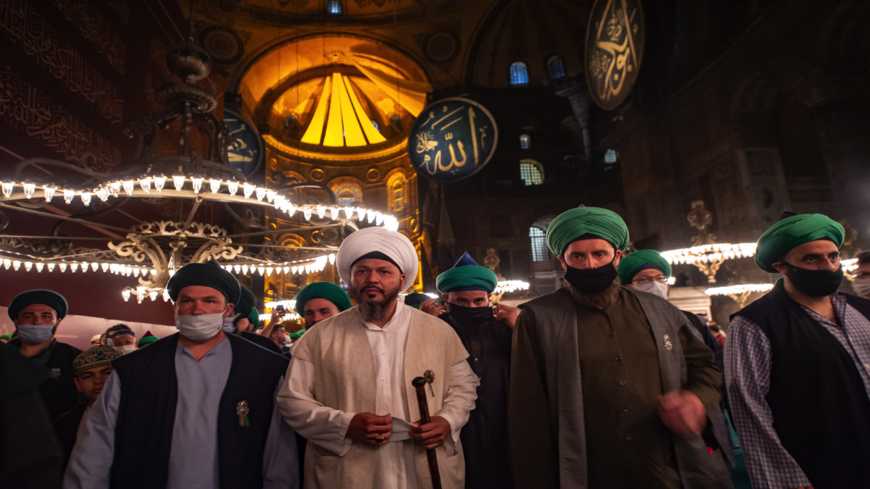Aug 4, 2020
At a time when the Turkish government’s decisions are further polarizing Turkish society and simmering the fault lines between secularists and conservatives, Muslims and non-Muslims, Turkey’s capital, Ankara, is slated to host an exhibition that spotlights two issues that touch a nerve: imprisoned Turkish philanthropist Osman Kavala and his long-standing efforts to promote interfaith dialogue.
After its Istanbul debut last year, the globetrotting exhibition, “Shared Sacred Sites,” which highlights interfaith dialogue, is planned to continue at Ankara’s only contemporary art museum, CerModern, from the beginning of November to December 2020. The curation of the Turkey exhibit is partly the result of consultations with Kavala, one of the prominent patrons of artworks and cultural initiatives that serve dialogue. Kavala has been behind bars for more than 1,000 days on flimsy charges that many see as politically motivated.
After traveling from Marseille’s MuCEM to New York City, Paris, Thessaloniki and elsewhere, “Shared Sacred Sites” debuted in Turkey at Istanbul’s Depo, an art space co-founded in 2008 by Kavala.
The Turkey part of the exhibition also features photographs from Istanbul’s Hagia Sophia, which was turned into a mosque on July 24 amid strong criticism at home and abroad.
The politicized reopening of Hagia Sophia as a mosque commemorated the Treaty of Lausanne, which led to the founding of the Republic of Turkey in 1923. Eleven years later, when Hagia Sophia became a museum, its treasury of Muslim heritage was arguably downplayed by Mustafa Kemal Ataturk, founder of the modern Turkish republic’s hard-line secularism. Islamic calligraphy on Hagia Sophia’s ceiling panels by Izzet Effendi is the largest of its kind in the world. As is evident from photography and art history, the panels were taken down and stowed away during its conversion to a museum.
Last year, before “Shared Sacred Sites” came through Depo from April to July, Kavala worked from jail with curators Manoel Penicaud and Dionigi Albera, advising on the inclusion of artworks relevant to Turkey. There are three photographs of Hagia Sophia by Izzet Keribar. His piece “Interior of Hagia Sophia” (2012) recalls the 1935 photographs of Dumbarton Oaks from inside the edifice, in which the calligraphic panels are conspicuously missing.
Kavala, who has been in Silivri prison since Nov. 1, 2017, is currently anticipating an indictment for allegations of espionage during the failed coup of July 2016. In February, the Silivri courthouse acquitted his earlier indictment for attempting to overthrow the government during the 2013 Gezi Park protests, but he was re-arrested the same day before leaving the prison.
“Shared Sacred Sites” embodies the principles for which Kavala stood and that are increasingly important as Turkey confronts international criticism over the problems of interfaith harmony.
While imprisoned, Kavala has continued to work with Depo, which is based in the building where his grandfather ran a tobacco business after their family endured the Greek-Turkish population exchange of 1923. The curation of the exhibition exemplified Kavala’s nonpartisan, pluralist, civil society advocacy.
“He is always gentle, considerate, altruist; he has always been open to dialogue and did a lot to bring people together,” Depo’s project coordinator, Asena Gunal, told Al-Monitor. She is also executive director of Anadolu Kultur, the not-for-profit cultural institution that Kavala founded in 2002 and still chairs from jail.
“They are punishing him not only because of his cultural work but also because of his collaboration and exchange with European civil society members and politicians,” she added.
Kavala has stirred political controversy for providing space to Kurdish artists, especially at the Diyarbakir Arts Center that he founded in the country’s embattled southeast, and for hosting civil society activities in his restaurant in Istanbul where artists and writers from different ethnicities could express themselves freely.
“Over the past two years [since Kavala’s arrest], solidarity and collaboration between artistic communities continued,” said Ferhat Ozgur, an artist and professor who worked with Kavala in the first Mardin Biennial in 2010. “Galleries have opened. … I believe Kavala is so happy to see us organizing. His arrest and the ongoing political crisis united us strongly, more than before,” he added.
“He was doing critical work, but not specifically critical of this government. What he does and has been doing at Depo is against the denial of past atrocities,” Gunal said.
The latest curation of “Shared Sacred Sites” at Depo is under further revision following the reconversion of Hagia Sophia. The remount in Ankara, a collaboration between Anadolu Kultur and The French Institute, will not only feature the work of Izzet Keribar on Hagia Sophia but also photography by Manuel Citak of Eyup Sultan Mosque, Surp Hresdagabed Armenian Church, Beth Yaakov Synagogue and the St. George Monastery on Istanbul’s Buyukada Island. Other works, by Gencer Yurttas for example, are focusing on interfaith shrines in Istanbul.
At Depo, the sprawling three-floor show portrayed common sacred spaces across Turkey, from Antakya, Cappadocia, Mardin, Ephesus and Dersim. CerModern, a larger space, anticipates the show’s renewed curatorial expansion.
“This project resonated very deeply with Kavala’s life-long engagement for dialogue and encounter beyond the conflicts and the differences,” Albera told Al-Monitor. “Osman Kavala monitored the preparation of the exhibit despite the severe limitations in his communication with the external world. We immensely admire his courage!”
By: Matt A. Hanson
Source: Al-Monitor



